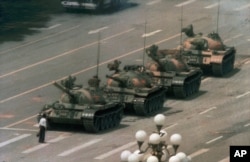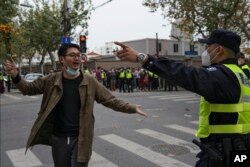Demonstrations broke out in several Chinese cities on November 25 to demand an end to the country’s severe COVID-19 restrictions.
Chinese security forces were quick to react to the protests. They fired pepper spray and tear gas against the activists. Later, police and army troops deployed huge numbers of military vehicles, trucks and cars on streets to block demonstrators.
The protests took place in Beijing, Shanghai and other mainland cities. News organizations reported the demonstrations were ended by November 29.
Police officers stopped people in the streets to check their identification documents and search their phones. They looked for pictures, messages or banned apps that might provide evidence of involvement or support for the protests.
It is not clear how many people were detained as a result of the protests nor if anyone will face charges.
Most of the protesters were seeking changes to severe government restrictions aimed at limiting the spread of COVID-19. But others turned their anger toward Chinese President Xi Jinping, with some even calling for him to resign.
Xi has led a push for the country’s “zero COVID” policy, which aims to isolate every infected person. It has helped keep China’s COVID-19 cases low, but it has also forced millions of people to remain in their homes. Many people have criticized the restrictions for preventing people from getting necessary food and medical supplies.
The latest protests were the most notable in China since the 1989 student-led pro-democracy movement on Beijing’s Tiananmen Square. But they were far smaller than the 1989 demonstrations. China’s People’s Liberation Army crushed those protests with tanks and troops, killing hundreds, maybe even thousands of people.
After the Tiananmen crackdown, the party invested in resources to deal with unrest without using deadly force.
During a wave of dissent by unemployed workers in the late 1990s and early 2000s, officials tested such a system. It centered on preventing organizers in different cities from linking up. Protest leaders were arrested, while lower level demonstrators were largely left untouched.
At times, the government has been caught by surprise. In 1999, members of the Falun Gong spiritual movement surrounded official buildings in Beijing to express opposition to government efforts to restrict the group. China’s ruling Communist Party saw Falun Gong – which was launched in the 1990s and grew to have tens of thousands of followers – as a threat to its power.
A severe crackdown followed the Falun Gong protest. Leaders were arrested and given heavy prison sentences. Group members were subject to harassment and sometimes sent to re-education centers.
In 2008, Chinese security forces fought back fiercely when anti-government riots broke out in Tibet’s capital Lhasa and unrest spread through Tibetan areas in western China.
The next year, a police crackdown on protests by members of the Uyghur Muslim minority in the capital of the northwestern Xinjiang region, Urumqi, led to bloody clashes. At least 197 people were killed in the fighting, mostly Han Chinese civilians.
In both cases, forces fired into crowds, searched door-to-door and seized an unknown number of suspects who were either sentenced to heavy terms or simply not heard from again. Millions of people were placed in camps and blocked from traveling.
China has been able to build up such resources because it has a huge internal security budget that reportedly has tripled over the past 10 years. The budget is now believed to be greater than the amount China spends on national defense. Xinjiang alone saw a ten-fold increase in security spending during the early 2000s, Western estimates suggest.
The published amount for internal security topped the defense budget for the first time in 2010. By 2013, China had stopped sharing specific information. The American think tank Jamestown Foundation estimated that internal security spending had already reached 113 percent of defense spending by 2016. Yearly increases were about double those for national defense in percentage terms. Both grew much faster than China’s economy.
China’s government has also built a large network to check online material for anti-government messages and unapproved news and images. Government censors work at all times to remove such material, while propaganda teams flood the internet with pro-party messages.
I’m Bryan Lynn.
The Associated Press reported on this story. Bryan Lynn adapted the report for VOA Learning English.
_________________________________________________________________
Words in This Story
app – n. a computer program that performs a special function, usually found on mobile phones
isolate – v. to separate someone or something from other people or things
crackdown – n. a serious attempt to punish people for doing something that is not permitted
harassment – n. the act of repeatedly attacking or bothering someone
internal – adj. of, relating to, or happening on the inside of an organized structure (as a company or state)
censor – n. a person who examines books, documents or films in an attempt to remove part that are offensive or not permitted by rules
_________________________________________________________________
What do you think of this story? We want to hear from you. We have a new comment system. Here is how it works:
- Write your comment in the box.
- Under the box, you can see four images for social media accounts. They are for Disqus, Facebook, Twitter and Google.
- Click on one image and a box appears. Enter the login for your social media account. Or you may create one on the Disqus system. It is the blue circle with “D” on it. It is free.
Each time you return to comment on the Learning English site, you can use your account and see your comments and replies to them. Our comment policy is here.












Forum